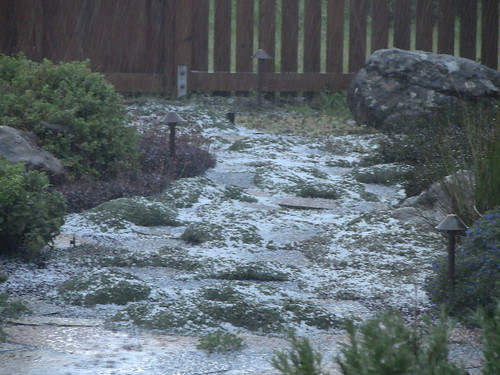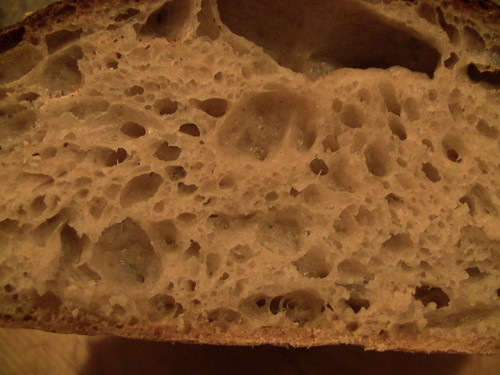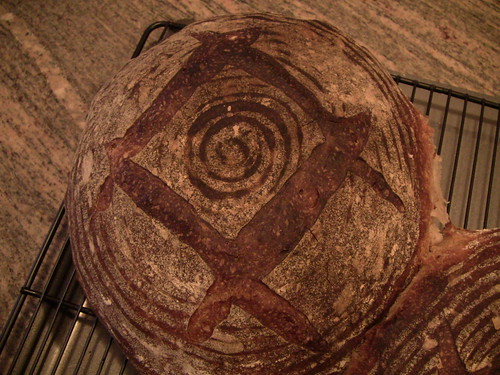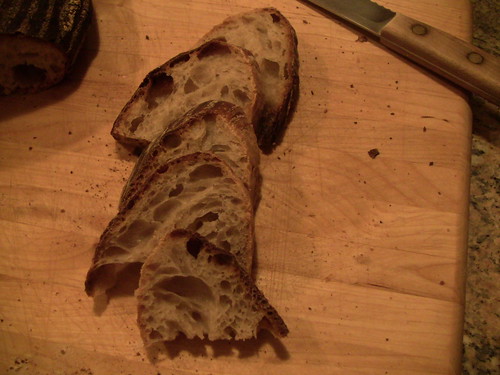But, first, the weather. Thunder, lightening and hail may not be a big deal to people in some localities. But in Northern California, they are rare as reliable weather-forecasting. Saturday, our morning coffee was interrupted by a crashing downpour of (admittedly small) hail. It went on for many minutes and accented our garden with glistening ice.
Now, back to bread.
I posted a question here a few days ago, asking how to achieve an airy, tender crumb in a sourdough bread, like the ones I’ve had from some local artisan bakeries. Several wise advisors suggested higher hydration, and mentioned Tartine’s Basic Country Bread in particular. I am among the diminishing group at TFL who had not previously baked that bread. This weekend I ended my holdout. And the result was just the crumb I’d been hoping for.
I found the formula at the breadexperience blog (http://breadmakingblog.breadexperience.com/2011/02/tartine-country-bread.html). I refreshed my basic sourdough starter (70%AP/20%WW/10%Rye at 75% hydration) on Friday morning. On Friday evening I made up the Tartine Leaven (50% white flour and 50% whole wheat at 100% hydration), using Central Milling Organic Artisan Baker’s Craft (malted) white flour and KAF whole wheat flour. By Saturday at 9 a.m., the leaven was bubbly, and passed the float test noted in the formula.
The final dough was very fluid, but after a 30 minute autolyse and four hours of fermentation, with a four or five stretch and folds every 45 minutes or so, it became somewhat firmer and silky, though still quite sticky. The sticky dough did not cooperate in the pull-stretch-rotate boule-forming technique, but I tightened the sheath as best I could, and plopped two blobs into well-floured 8-inch wicker brotforms. They proofed for about four hours at room temperature, and grew about 25%, passing the poke test.
Then the real mess ensued. Those blobs did not want to come out of their brotforms. The edges of the blobs stuck to the rims of the brotforms and the “loaves” (if you can call them that) spread out on the parchment, defiantly declaring themselves to be pains rustiques. I had decided to bake the loaves on stone with lots of steam, instead of in Dutch Ovens. And the spreading blobs didn’t quite fit on my stone. They melded together in the middle and almost oozed over the edges of the stone.
Thank goodness for a fully-preheated stone and the steam power of Sylvia’s Magic Towels plus a cast iron skillet with lava rocks. The steam heat quickly gelled the oozing masses into something like loaves before they totally lost all form. And they rose up like they were full of gas.
After 20 minutes of steam, I turned the oven from 450F to 420F with convection, and let the loaves bake for a total of 38 minutes, then left them on the stone with the oven door ajar to dry the crust for another 10 minutes.
Though these are not the best formed loaves I’ve baked, I could tell from their weight the moment I moved them from the oven to the cooling rack that they were going to be light-crumbed and open-celled.
This is pretty close to immediate gratification. I go to TFL with a question. I get some answers. I follow the advice. And it works!! The crust was fairly thin and crispy when just cooled yesterday (or toasted today), and only slightly chewy today. The crumb is deliciously tender and moist, even the day after. The flavor is subtle, compared—say—to San Francisco Sourdough or the Hamelman Vermont, but very nicely complex in a delicate way.
We made a “bread dinner” of things that go great on sourdough—tuna salad, proscuitto, gorgonzola and a spread of chopped pear, chopped pecans and gorgonzola. Washed down with a nice Pinot Noir Rose'. And it was gooood!
Thanks to all for the very good guidance. I got a happy result, but my crumb quest continues--can I achieve this crumb texture consistently?
Glenn
- GSnyde's Blog
- Log in or register to post comments





Lovely open crumb, Glenn. And despite the fact that you got Simamese twins, I think your loaf looks very handsome with the diminishing brotform spiral on top! I love the hail in the garden pic, too. As always, entertaining reading.
All the best,
Syd
It's amazing how fun bread-baking can be when you set out to achieve a particular result, and you actually manage to do it!
I have to wonder whether the bread would have been even better if the boules hadn't de-formed.
Glenn
Looks Beautiful, Glenn!
I just posted at Syd's quest, my favorite.
Your scoring looks like a shield...perfect for your quest.
We are very cold here today and waiting for your rain to arrive here...maybe even some hail!
Sylvia
A noble quest, indeed.
Thanks for the nice comment, Sylvia.
Glenn
Beautiful boules, Glenn! It doesn't look like the sticking did much damage from your results. You could have dusted the brotformen more heavily, but then you wouldn't have had such a nicely defined flour pattern on the loaves.
The Tartine BCB vies with the SFBI miche for "current favorite" honors chez nous. I hadn't realized you hadn't baked it before.
David
It was quite a day of nasty weather yesterday. Good thing I had to finish writing an article and so couldn't have gone out to have fun anyway. I think Fort Bragg had about 6 inches of rain in the the last four days. When we were driving back to SF today, the Navarro River was a muddy torrent, lapping at the edge of Highway 128 about five miles inland.
As to the BCB, I'll definitely be baking it regularly. I may try slightly smaller loaves and will certainly find a way to keep the dough from attaching to the proofing basket.
Thanks for the comment.
Glenn
Hello Glenn, I'm glad you found the crumb you were looking for.
Thanks for asking the 'tender crumb' question - prompting all of those good responses and Syd's bake -
(Soft, tender-crumbed Sourdough) - although I love Tartine BCB, Syd's formula was just what I was looking for, as it looks so very close to the bread I want to try recreating here at home.
Light and open-celled bread is a delight, isn't it?! Nicely done!
from breadsong
Yes, this kind of bread is a real treat. Now that I hit the mark once, I need to make sure I can do it consistently. Then I'll try some variations like a higher percentage of whole grain.
Glenn
Very Nice Results..Glenbn! Very gratifying to see those loaves baloon up in the oven.. Nice work... if you fermented the loaves well, they will come to life in a hot, well steamed oven.
Thanks, Khalid.
I agree that proper fermentation is another key to the open cell structure. The primary fermentation and proofing were each about four hours at room temperature (around 70 F), with a dough temperature after mixing of about 75 F.
Glenn
The first couple of times I made the BCB I divided the dough just after fully mixing it and had it go through the bulk fermentation in two 2qt containers. It was easy to manipulate this way (I have very small hands). This weekend I left it altogether in one and had a devil of a time turning it. When it came to dividing and shaping that unmanageable mass it just taunted me into over handling so that this time I didn't get the really open holes as much in the crumb. It was still tender enough to opt out on the pannini press at lunch and just diving in.
I thought it was just me...so I'm glad to hear it behaves like The Blob with someone else.LOL
I'm going back to dividing it next time. It's also easier to retard one so the loaves are more consistant when baked separtely since I do the DO method.
Thanks for helping me acknowledge the differance.
Bake on...
Dosi
I didn't find it difficult to ferment (with S&Fs) in one large blob. The problems started when I tried to shape the sticky half-blobs and then transfer them to parchment. I'll try using a bit more flour in the process.
Glenn
The hail and the bread... the most enjoyable meals are frequenty the most simple ones!
Toni
Glenn
had a tough fight with those blobs, Glenn - reminds me of some struggles with unmanageable dough monsters in my kitchen. But the result looks very nice!
I made the Basic Country Loaf a while ago, and, like Dosi, divided the dough right after mixing. It really makes a difference! I loved the taste of the bread, and will definitely make it again.
Karin
I don't understand the problems cited with stretching and folding large dough masses. Maybe it's the container? Small hands shouldn't make a difference.
At SFBI, we were told that larger doughs develop better flavor. Most of the breads we made were fermented in batches of around 25 lbs. Sometimes, we did the S&F in a dough tub. Sometimes on the bench. It was never a problem.
The many videos on youtube.com illustrate techniques.
If you can be more specific about the problem, maybe we can help.
David
Glenn, I am very impressed with your effort here. I am curious about why it took so long to ferment. The cold snap? How did you know how long to go on the bulk ferment? You were obviously right because the crumb came out so nicely. -Varda
Thanks, Varda.
I guess the slow primary ferment is due to the amount of starter in the final dough. It was a strong starter, and our kitchen temperature is around 70F.
To judge when the dough was ready to be shaped, I used a combination of factors. I took into account the recommended 3-4 hours in the formula, and the look and feel of the dough. It had increased in size about 25 -35 % and was just getting pillowy and showing good gas bubbles.
Glenn
Oh. I had just assumed that it went unusually long but I just followed the link to the recipe. I see that the prefermented flour is only 10% - that must account for the longer fermentation time. So many variables. Thanks. -Varda
Nice looking breads Glenn. I think you would benefit from getting the book and reading the procedure from Robertson. There are some very interesting details that make a big difference in the outcome. I would suggest trying out a Lodge combo cooker and baking just as illustrated in the book. I have been very happy with my boules baked in the CC and find the ease of operation and short pre heating to be helpful.
Another thing you might think about is using a linen lined proofing basket from sfbi. I have stopped using the coiled baskets and have not had a worry about sticking since the switch. The high hydration doughs pop right out into the shallow section of the CC every time. I scale my loaves to be just at 2 lbs.
Eric
Eric, it works well, even with Tartine's bread, if you flour the coiled baskets enough.
I tried the method described in some TFL posts, using half AP/half rice flour, and, after some loaves sticking to the baskets, went back to my old way of sprinkling the bannetons with bread flour, or the flour I use most in the bread.
Though the breads look a bit more rustic, the spiral pattern is still visible, and the thicker flour coat helps releasing the breads.
Karin
I appreciate the comments and the good advice.
The linen-lined baskets I have are larger than I wanted to use for these loaves, plus I love the coil pattern. I'll try both linen-lined baskets and better-floured brotformen over time (I'm going to be baking this bread a lot!). I will also bake them in a Dutch Oven some time.
Glenn
I just found this follow up after I posted my questions on your previous blog, so I think my questions will be answered here. So you didn't use the water roux, I am assuming. Thanks for posting pics & helpful links! I am from Northern California, too.
Hi, Oceanicthai. I did not try the water roux. I followed the Tartine formula this time.
Glenn